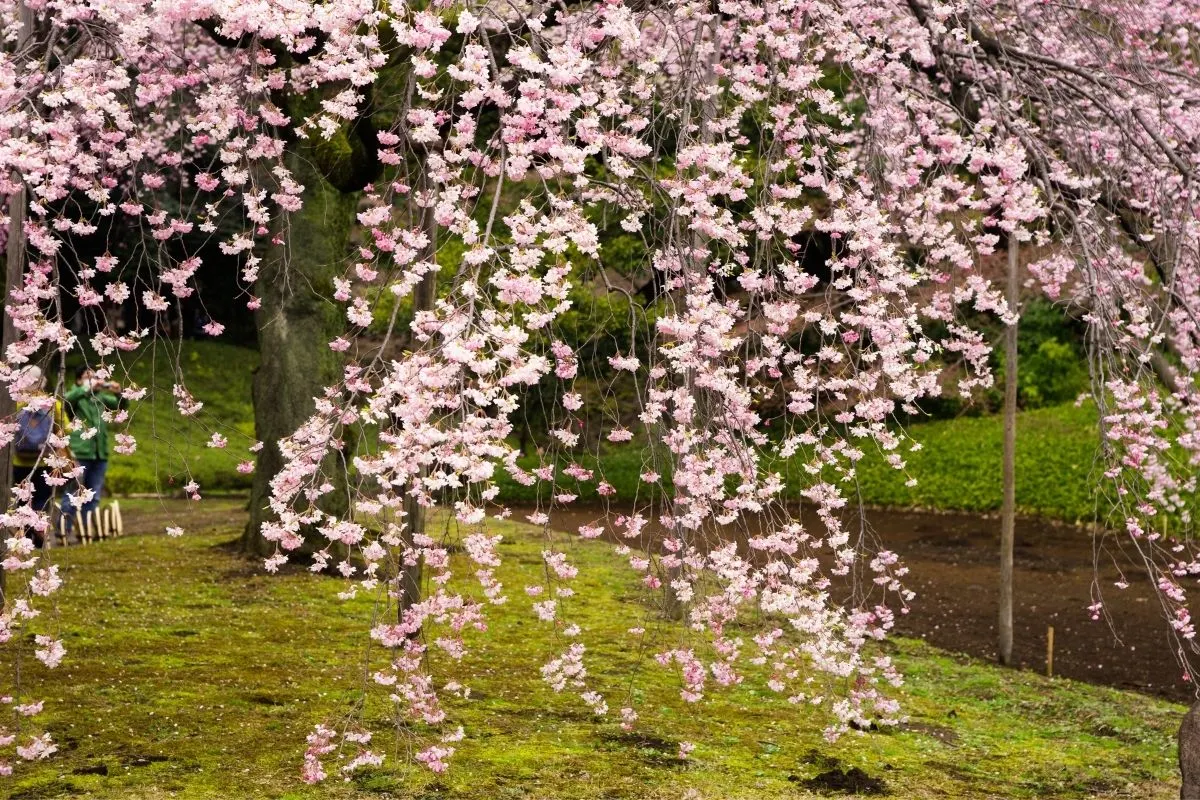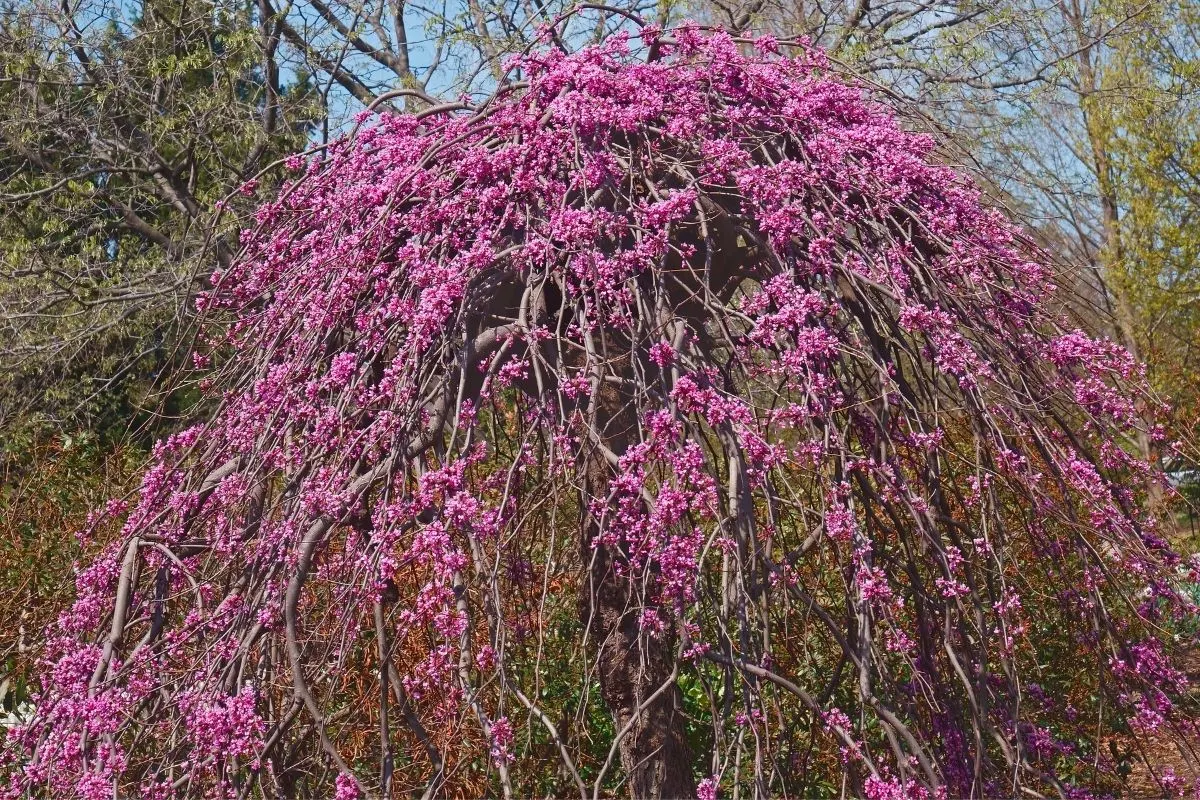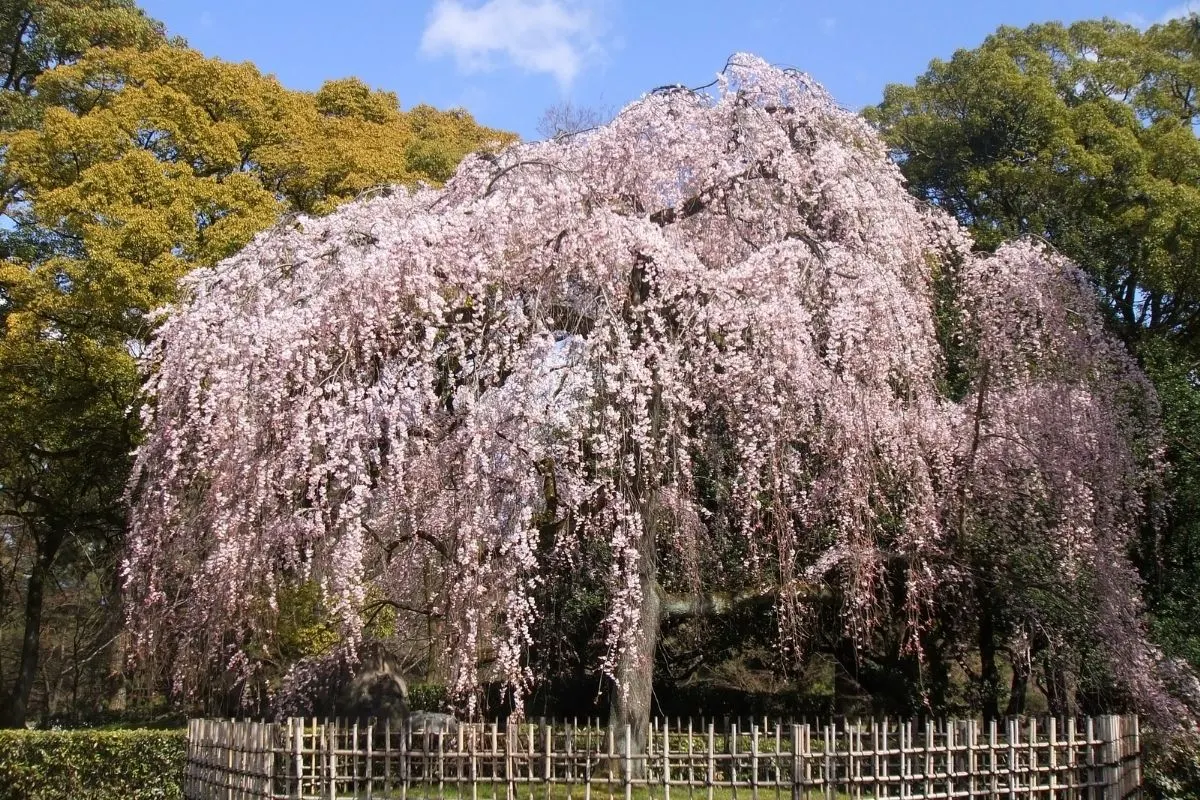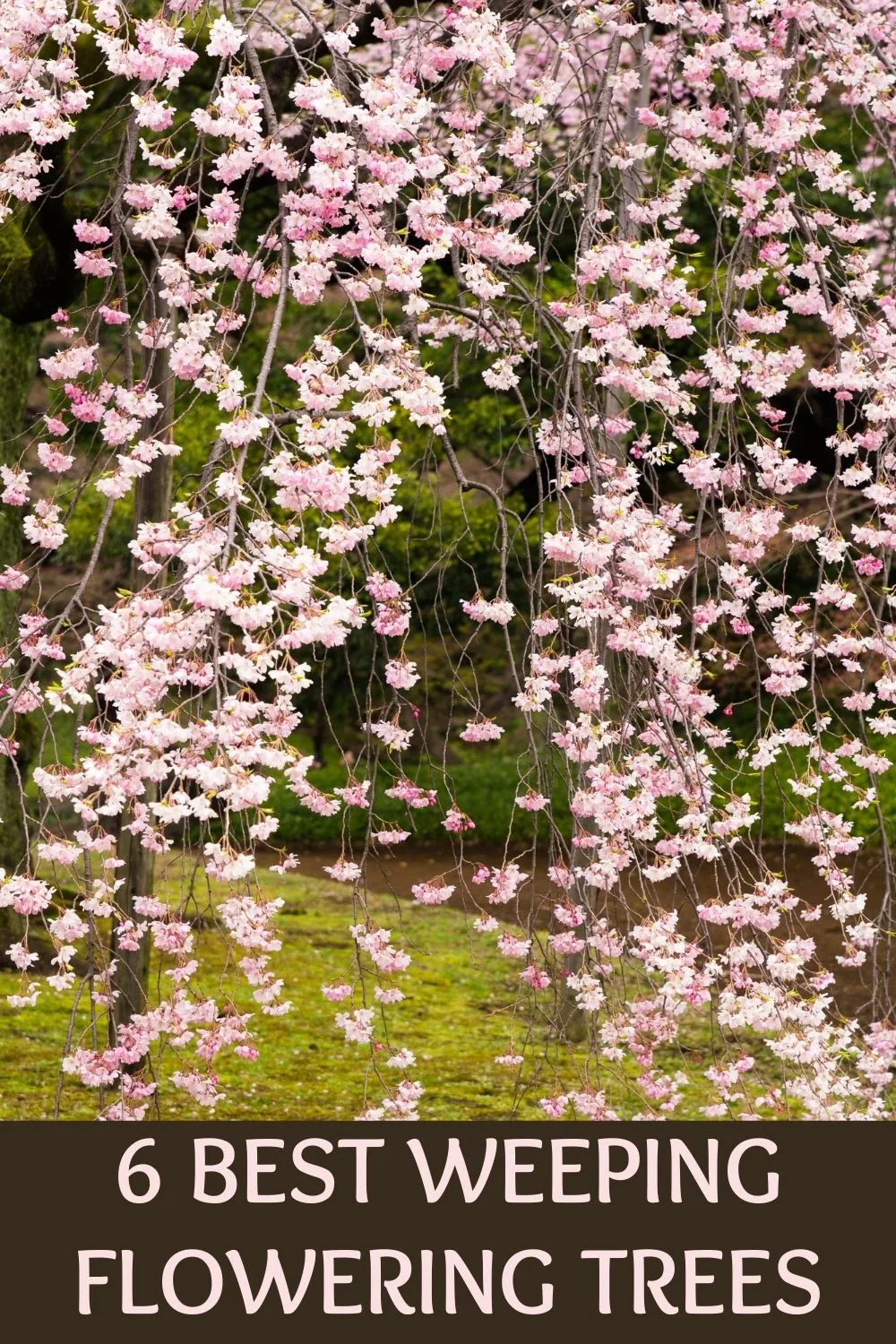Have you ever sat beneath the branches of a stately weeping willow in full bloom in late winter? Or have you ever taken in the sight of a weeping cherry tree in full flower in the spring? If you have, you know how lovely the weeping habit can be. Trees with weeping habits are among the favorites of ornamental trees, and even more so, weeping flowering trees.

With branches filled with flowers that cascade from the trunk like colorful streams down a mountainside, flowering weeping trees are coveted treasures in yards and gardens everywhere. In this article, we will review some of the most versatile weeping flowering trees that you can make a part of your landscape.
Weeping Flowering Trees for Every Landscape
1. Weeping cherry, also known as weeping higan cherry
(Prunus pendula Pendula Rosea, for single flowers, and Prunus pendula Pendula Plena Rosea, for double flowers)
The weeping cherry is a specimen tree prized for its spring flowers and for its year-round weeping form. It is not grown for tree fruits, although birds enjoy its small, black fruits in the summer. Weeping cherries are prone to diseases and pests and require both full sun and good airflow, but they can add beauty to your landscape for decades with the right attention and care.
Always plant weeping cherries in the sunniest part of your landscape. Sunlight encourages flower production and discourages fungal diseases.
Never plant weeping cherries in boggy soil. They need good drainage and loamy soil. Standing water encourages root rot. Weeping cherries require continuous moisture throughout the growing season but don’t do well when they are flooded.
Weeping cherry trees usually require very little pruning, but be sure to trim any suckers that may sprout below the graft near ground level.
Weeping cherry trees tolerate cold and heat better than most other ornamental cherry trees, so if you haven’t found success with other varieties of flowering cherries, this cherry may be worth a try. They are best adapted to USDA Hardiness Zones 5 through 8.
About the weeping higan cherry (Prunus subhirtella Pendula)
Higan cherries are larger than some other varieties of weeping cherry, growing as much as 30 feet (10 tall). Their flowers are light pink, almost white, covering the branches until the leaves come out. Leaves are dark green during the growing season and yellow in the fall.
The small, black fruits are not noticeable on the tree and do not cause a litter problem. Be aware that this tree requires pruning the first three to five years after it is planted to develop unbreakable limbs.
Paradoxically, these trees develop fungus problems in drought conditions, rather than during rainy weather. Keep them well-watered to keep them healthy.
2. Japanese Maple (Acer palmatum)
Japanese maples can become the focal point of a small garden for twelve months of the year. They can be patio plants grown in large containers, or they make great bonsai plants, or they can be accent plants in cool gardens with water features.
Their pendulous stems bear cymes of small flowers with white petals and red or purple sepals. Then the tree is covered with spectacular purplish-red foliage, providing you can provide your tree with enough light, but not too much light, and protect it from the summer heat.
In the fall, Japanese maples are covered with foliage of red, yellow, orange, and purple.
If you aren’t growing your Japanese maple in a container, choose a location with dappled sun or partial shade where it can grow 25 feet (8 meters) tall. Planting your Japanese maple under evergreen trees, like well-established Eastern white pines, is an excellent choice. Pines will give it nearly perfect light conditions.
Japanese maples are not as fussy as their reputation suggests when they are planted in the right place, but there are three considerations:
- With too much heat and too much light, the iconic purple foliage of the Japanese maple goes green.
- Alkaline soil causes leaves to turn yellow. Keep soil conditions acidic, with a pH around 5.5.
- Be alert to pests and diseases, especially Japanese beetles, aphids, root weevils, and fungal diseases.
3. Weeping redbud ‘lavender twist’ (Cercis canadensis)

Weeping redbuds can provide the first hint of color beneath a canopy of deciduous trees every spring. Every branch pops out with hundreds of tiny, purplish-rose flowers that bloom for several weeks before the tree’s leaves come out.
Weeping redbuds are the same species as the more familiar Eastern redbud, found in nature and in home landscapes from southern Canada across the eastern half of the United States. Left alone, this variety will grow into an umbrella shape, but if it is pruned during its dormant season, it will grow straight like other redbud trees.
Weeping redbuds can reach a height and spread of 20 feet (6 meters). They are happy in partial shade under taller deciduous trees, although they don’t grow well under evergreens. Although redbuds will grow in almost any kind of soil, from the rocky alkaline soils of the American Southwest to the intensely acidic soils of Northeastern humid forests, they prefer loamy soil with good drainage.
Once a redbud tree has been established, it does not transplant well.
Weeping redbuds are winter-hardy in USDA Hardiness Zones 4 through 9. They benefit from mulching in cold-winter areas. These trees are relatively short-lived, and may not survive prolonged drought or extreme cold.
4. Weeping crabapple (Malus species)

Weeping crabapples add interest to your landscape year-round. Its downward-turning, cascading branches produce pink or white flowers for a few days up to two weeks in the early spring. Then, dark-green foliage and small red, yellow, or orange fruits provide visual interest from mid-summer to late fall. The half-inch (10 mm) fruits are a favorite with birds and squirrels, although most gardeners will find them to be too tart for easy eating.
Weeping crabapples grow slowly, as little as 6 inches (15 cm) a year for the first year or two. They eventually grow 10 to 15 feet (4 to 5 meters) tall and 8 to 15 feet (2 to 5 meters) wide. They prefer rich, well-drained, acidic (pH 5.5 to 6.5) soil, and are winter-hardy in USDA Hardiness Zones 4 through 8.
Keep in mind that weeping crabapples will drop fruit in late fall and early winter. The fruit can stain concrete and stone, so do not plant them within 15 feet (5 meters) of a driveway or sidewalk. Crabapple seeds are toxic to both people and animals.
Some varieties to consider include:
- “Louisa.” This variety is best for smaller spaces. This small tree grows just 10 feet (3 meters) tall. It bears pink flowers in the spring, dark-green leaves in the summer, and small, yellow apples in the fall.
- “Molten Lava.” If you have had problems with diseases, try this disease-resistant variety. It is covered with white blossoms in the spring and grows up to 12 feet (4 meters) high.
- “Red Bud.” This crabapple has branches that droop from its tips. It bears bright red fruit and leaves that turn a golden yellow in the fall. It grows up to 20 feet (6 meters) tall.
- “Red Jade.” Growing to a height of 15 feet (5 meters), this crabapple bears pink flower buds that open to reveal white blossoms. Its fruit is cherry red and remains on the tree until early winter.
- “Royal Beauty.” Plant this crabapple for its purple foliage and red crabapples that appear in late summer and remain on the tree until mid-winter. Royal Beauty grows about 10 feet (3 meters) tall but gets wider with age.
5. Weeping willow (Salix babylonica and related hybrids)
There is a lot to like about weeping willows.
Weeping willows are beloved for their long, delicate, weeping branches that graze the ground with flutters of silver-tipped leaves. They provide shade from a pleasingly round canopy in the summer. And they are among the first flowering trees of late winter and early spring.
Weeping willows thrive next to waterways, so they help to conserve soil. They tolerate many different kinds of soil. They provide food and shelter for birds and wildlife. Golden leaves make them just as beautiful in the fall as they are in the spring.
A weeping willow can be the focal point of a waterside garden. It is not a good choice for small gardens. This tree can grow 30 to 50 feet (8 to 15 meters) tall and spread 30 to 40 feet (9 to 12 meters) across. It tolerates partial shade but prefers full sun. Weeping willows are adapted to USDA Hardiness Zones 4 through 10.
Because weeping willows have long roots, it is important not to plant them near sewer pipes or underground power lines. Be forewarned that weeping willows have multiple disease challenges (willow blight, willow scab, powdery mildew, black canker, root rot, and more) and several pest problems (borers, aphids, and gypsy moths).
If you like weeping willow tees, make sure you take a look at these two below:
- Niobe weeping willow (Salix alba tristis ‘Niobe’)
- Weeping French pussy willow (Salix caprea ‘Pendula’) – this is absolutely GORGEOUS!!!
6. American wisteria (Wisteria frutescens)
Looking for an exceptionally easy-to-grow flowering plant that can take on a weeping form? The American wisteria, also known as Kentucky wisteria, is a non-invasive woody vine that can produce sprawling blooms over archways and pergolas, and other support structures, without some of the problems of the more invasive, poisonous Chinese wisteria.
American wisteria produces fountains of blue, purple, or white blossoms that can last as long as eight weeks in late spring and early summer. A legume, this plant is then covered with attractive bean-like pods.
Regular pruning stimulates new flowering into the summer, giving it another advantage over the Chinese wisteria, which blooms just once every spring. Just don’t remove too much wood, or prune it at all after mid-summer. This plant only blooms on last year’s growth.
This plant is a great choice for fences, arbors, trellises, and arches, but it is not a good choice for growing up the side of your home. As it reaches its eventual height of 30 feet (8 meters) or more, it can get so heavy that it damages masonry or drainpipes.
Plant American wisteria in full sun for best bloom (learn more about how to grow wisteria). The vine will grow in dappled shade, but it will not produce as many flowers. American wisteria grows near streams and waterways in nature, so it both tolerates flooding and needs regular moisture. Learn more
American wisteria is winter-hardy in USDA Hardiness Zones 5 through 9.
Plant American wisteria in well-drained acidic to neutral soil. If your American wisteria is planted in alkaline soil, it will grow yellow, chlorotic leaves.
Still looking for interesting flowering trees with a weeping habitat?
Consider these:
- Chinese weeping willow (Salix matsudana)
- weeping fig (Ficus benjamin)
- weeping mulberry (Morus alba ‘Pendula’)
- weeping silver linden (Tilia petiolaris)
- weeping Yoshino Prunus x yedoensis var. perpendens)
With a little searching, there is a weeping flowering tree for every landscape.







10 Types Of Flowering Trees For A Beautiful Yard
Wednesday 20th of April 2022
[…] filled with flowers that cascade from the trunk like colorful streams down a mountainside make weeping flowering trees coveted treasures in yards and gardens everywhere in the United States and […]